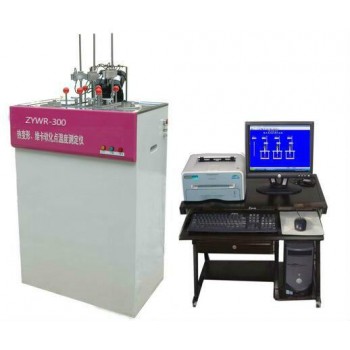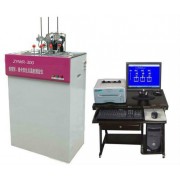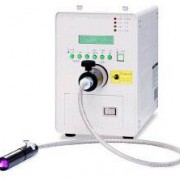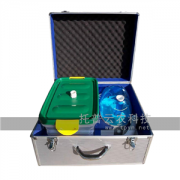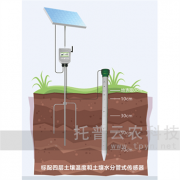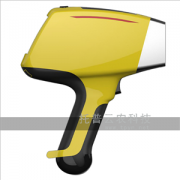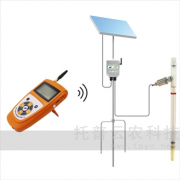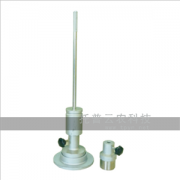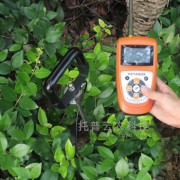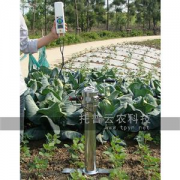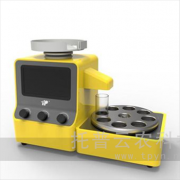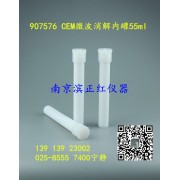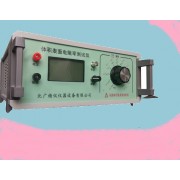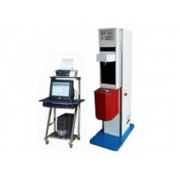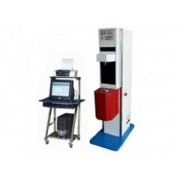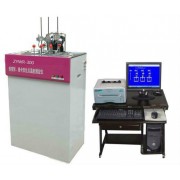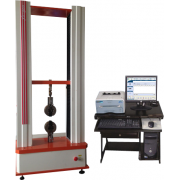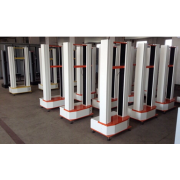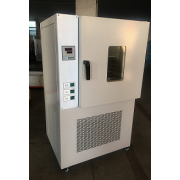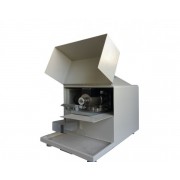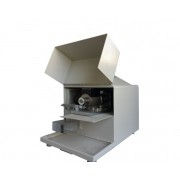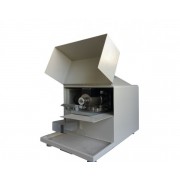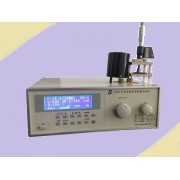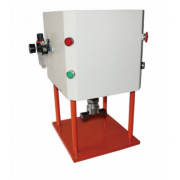适用于测试高分子材料的维卡软化点温度和热变形温度
作为控制质量和鉴定新品种热性能的*个指标,
由百分表测量形变,
温控仪设定升温速度,
试样架自动升降,
*次可试验三个试样
操作方便、设计新颖、外形美观、可靠性高。
热变形、维卡软化点温度测定仪,是为适应塑料工业的高速发展和提高材料的研究和测试水平,采用新国际和国*标准设计而成的。该仪器性能稳定、测控准确、操作简单、自动化程度高,是国内目前用于非金属材料的变形和软化点温度检测的理想产品。
采用标准
Ø ISO75-1:1993《塑料-负荷变形温度的测定》
Ø ISO306:1994《塑料-热塑性塑料维卡软化点温度的测定》
Ø GB/T1633-2000《热塑性塑料维卡软化点温度的测定》
Ø GB/T1634-2001《塑料-负荷变形温度的测定》
仪器安装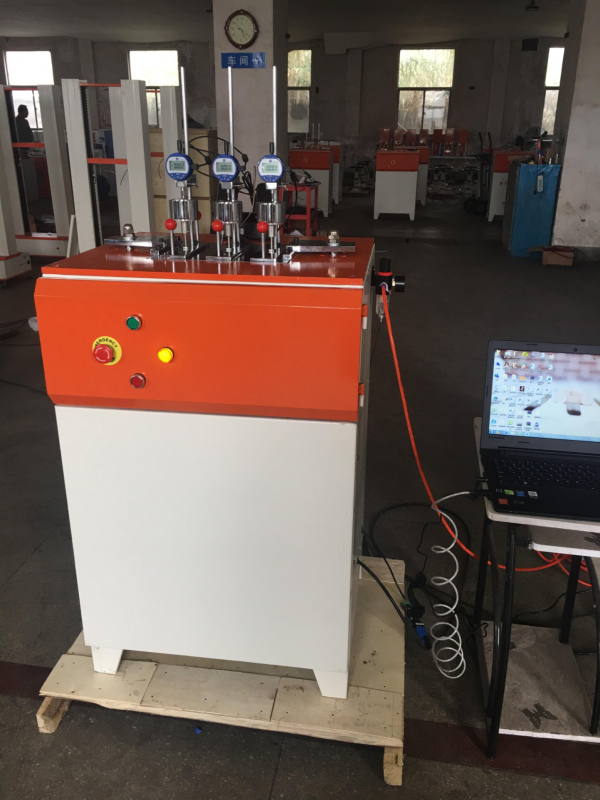
打开包装箱,依次取出各部件,装箱单进行清点,如有不符,请立即与我公司联系。
仪器要放在干燥通风、无振动的水平工作台上,并安放平稳,有条件可在主机主方安装通风设备。
拧紧放油阀,注意其中的铜垫要垫好,以免漏油。将甲基硅油或变压器油沿试样架槽上方加入油池,油面距池内顶部约40mm-50mm为止,放油阀在仪器后下方。
连接各部件线路:
1. **安装位移传感器。将1#传感器连接到1号插座,2#传感器连接到2号插座,3#传感器连接到3号插座。(位移传感器连接头为小USB口,设备连接头为标准USB口,对应连接即可)
2. 将温度传感器航空插头和两个搅拌电机的航空插头分别与设备上对应的插头连接好
3. 连接电源,将220V交流电源通过带漏电保护开关的空气开关(用户自配)后,与仪器相连,仪器电源连接接口,它使用三芯航空插头,其中两根接220交流的火线和零线,另*根为保护地线,保护地线与仪器外壳连接,*定要注意区分,并将保护地线良好接地,以免发生漏电危险。
!*定要注意区分电源和保护地线,并将保护地线良好接地,以免发生漏电危险。
4. 安装压头:根据试验类型选择压头的安装方式,热变形试验为横装(图1),维卡软化点试验为竖装(图2)。在附件箱中取出试样架,将压头安装在试样架负载杆下端,拧紧螺钉。如图所示。
将试样架放于主机上面的试验槽内。
将三只传感器依次安装到试样架上的传感器座中,将顶丝拧紧。安装时请注意传感器编号,按顺序安装。
接通电脑电源和控制箱电源,注意每*个电源都必须有良好接地线,以确保安全。
橡胶、尼龙、电*缘材料、长纤维增强复合材料、高强度热固性层压材料等非金属材料的热变形温度及维卡软化点温度的测定。采用数显表控制方式,PID调相输出,具有上限温度设定,试验温度达到上限温度时自动停止加热;有急停开关设置,且后控制面版为带锁的门式结构,便于机器检修、维修;该仪器操作方便、控制[敏感词],是*种智能化*高的测试仪器,广泛应用于大专院校,科研单位及产品质量监督检验单位。
试验操作步骤
*电控箱操作:
1、制备试样
A、热变形试验按照试验标准制作样条*般长宽高为120mm×10mm×4mm,如果宽、高的数据不标准,需在式样大小里将实际数据修改。
B、维卡软化点试验样条*般为片状试样,厚度在3-6mm之间,长和宽要大于10×10mm,或是直径大于10mm的圆片。
2、安装试样
做热变形试验时,将试样放在两个圆形支柱上,试样要放正,且不要与试样架两边接触。做维卡软化点测试时,将试样直接放在压针下即可(传感器的安装方式要注意 为传感器在下,砝码托盘在上)。然后放下负载杆(负载杆放下时要注意热变形压头要在滑槽内顺畅滑动,安装如图4),把试样架放回油池内。如图3 为热变形式样安装方式 图5为维卡软化点式样安装方式
3、操作界面介绍
接通主机电源和控制箱电源,主机电源接通后,搅拌电机以均匀的速度转动。
1)参数设置
1. 清空 :用来清除历史数据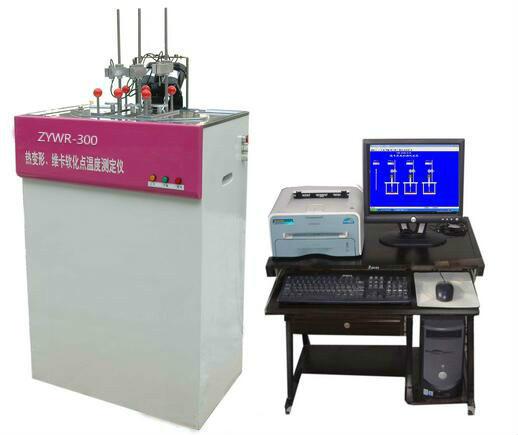
2. 蕞高温度:达到蕞高温度停止加热,防止油温过高发生火灾
3. 温度修正: 修正显示温度与标准温度的差值点击数字框跳出键盘修改
4. 修改完成数据后 要点保存按键才能生效
2)开机界面
开机后显示有三个试验方法,点选择可进入到相应的试验方法内
3)试验界面
1. 维卡软化点试验
启动:点击启动键 设备进入试验状态,*搅拌5分钟后开始以设定好的加热速率加热
切换:切换试验方法,内有A120 B120 A50 B50 试验方法切换重量也会跟随切换 (显示的重量是已经刨除掉传感器的弹力的,直接选择对应的砝码放上即可)
式样:式样1 式样2 式样3 可以选择或取消,开机默认3个都选择的,选择状态为绿色,当哪个传感器不做试验的时候必须取消掉,否则加热位移不会有变化,等温度升到蕞高限才会停止加热
当需要切换试验方法的时候,点击1.维卡软化点试验 这个字的位置就可以复位到开机界面从新选择试验方法。
2. 热变形试验
其它功能键与维卡里相同
热变形里有A1.8MPa、B0.45MPa、C8MPa三个压强方法,
在热变形试验里 点击跨距、宽度、高度下方对应的数字即可对式样尺寸进行编辑
当选择不同的试验方法和不同的跨距和宽带厚度的时候,系统会自动计算出变形量,和配重并显示出来,选择合适的砝码放上即可(本公司提供的砝码是式样在跨距64mm,宽度10mm,高度4mm的配重,其它的尺寸需要用户自己用天平称配)
3. 自由试验
在自由试验里,切换功能键不起作用
重量、跨距、宽度、高度 这几个参数可以修改但并不参与任何计算,只起记录作用
变形和加热速率可以任意设定 只需要点击数字即可进行修改
4)试验过程
在正确安装好试验后,打开设备电源,然后将位移传感器调节到2±0.1mm范围内(调节位移时,可*将传感器探针与砝码托盘下端接触,然后锁死微调手轮固定件,再通过调节手里将位移调到系统要求位移,然后锁死传感器固定件)
调节好位移后,在操作界面点击启动按键即可,中途如需终止试验可再次点击启动按键。
点击启动后,设备进入搅拌状态,在搅拌5分钟后,进入加热状态,当所有的式样的变形量(如有取消的不计算变形量)达到设定值后设备停止加热,并弹出保存界面,编辑保存名称点保存即可,存储的数据可在历史数据里查看。
使用注意事项与设备维护保养
1、 所有连接线*定要连接正确,并且电源具有可靠接地。
2、 仪器电源要稳定,且附近不可以有大功率用电器或强干扰的用电器,以保证检测结果的准确性。
3、 安装或取出试样时注意不要掉进油池内,如果掉进油池,*定要取出后再进行试验。
4、 负载杆和导管间要经常用酒精或其它清洁剂清洗,但不能加润滑油类。
技术参数:
1. 电源:AC220V±10% 20A 50Hz
2. 温度范围:室温--300℃
3. 升温速度:A:12±2℃/6min
B:5±1℃/6min
4. 试验*大负荷:A速度时为10N±0.2N
B速度时为50N±1N
5. 变形测量范围:0--1mm
6. 变形测量误差:0.01mm
7. 加热介质:甲基硅油
8. 加热功率:4Kw
9. 冷却方式:150℃以上自然冷却
150℃以下水冷或自然冷却
10. 外型尺寸:720mm×700mm×1380mm
11. *大温度误差:±1℃
12. *大加热功率: ≤4500 W
13. 重量:180Kg
Features and uses:
Suitable for testing Vicat softening point temperature and thermal deformation temperature of polymer materials
As an indicator for controlling quality and identifying the thermal performance of new varieties,
Measure deformation using a dial gauge,
The temperature controller sets the heating rate,
Automatic lifting of the sample holder,
Three specimens can be tested at once
Convenient operation, novel design, beautiful appearance, and high reliability.
The thermal deformation and Vicat softening point temperature tester is designed using new international and national standards to adapt to the rapid development of the plastic industry and improve the research and testing level of materials. This instrument has stable performance, accurate measurement and control, simple operation, and high degree of automation. It is currently an ideal product for deformation and softening point temperature detection of non-metallic materials in China.
Adopting standards
Ø ISO75-1:1993 "Plastics - Determination of deformation temperature under load"
ISO306:1994 "Plastics - Determination of Vicat softening point temperature of thermoplastic materials"
GB/T1633-2000 "Thermoplastics - Determination of Vicat softening point temperature"
GB/T1634-2001 "Plastics - Determination of deformation temperature under load"
Instrument installation
Open the packaging box, remove each component in sequence, and check the packing list. If there are any discrepancies, please contact our company immediately.
The instrument should be placed on a dry, ventilated, and vibration free horizontal workbench, and placed smoothly. If possible, ventilation equipment can be installed on the host side.
Tighten the oil drain valve and ensure that the copper gasket is properly padded to prevent oil leakage. Add methyl silicone oil or transformer oil to the oil pool above the sample holder slot, with the oil level approximately 40mm-50mm from the top of the pool, and the oil drain valve located below the back of the instrument.
Connect the wiring of each component:
Firstly, install the displacement sensor. Connect sensor 1 to socket 1, sensor 2 to socket 2, and sensor 3 to socket 3. (The displacement sensor connector is a small USB port, and the device connector is a standard USB port, which can be connected accordingly.)
2. Connect the aviation plugs of the temperature sensor and the two mixing motors to the corresponding plugs on the equipment
3. Connect the power supply, connect the 220V AC power supply to the instrument through an air switch with a leakage protection switch (provided by the user), and connect it to the instrument power supply interface. It uses a three core aviation plug, two of which are connected to the 220 AC live wire and zero wire, and the other is a protective ground wire. The protective ground wire should be connected to the instrument casing, and attention should be paid to distinguishing it, and the protective ground wire should be well grounded to avoid the risk of leakage.
! Be sure to distinguish between the power supply and the protective ground wire, and ensure that the protective ground wire is well grounded to avoid the risk of leakage.
4. Installation of pressure head: Select the installation method of the pressure head according to the test type. The thermal deformation test is horizontal installation (Figure 1), and the Vicat softening point test is vertical installation (Figure 2). Take out the sample holder from the accessory box, install the pressure head on the lower end of the load rod of the sample holder, and tighten the screws. As shown in the figure.
Place the sample holder in the test slot above the host.
Install the three sensors in sequence into the sensor seat on the sample holder and tighten the top screw. Please pay attention to the sensor number during installation and install in sequence.
Connect the computer power and control box power, pay attention to each one


